Here’s a list of the top dinosaur and fossil finds of 2014, from a small cat-sized dinosaur to the most complete giant titanosaur yet discovered and the largest-ever flying bird.
1. Dreadnoughtus schrani, a giant titanosaurian dinosaur from Argentina:
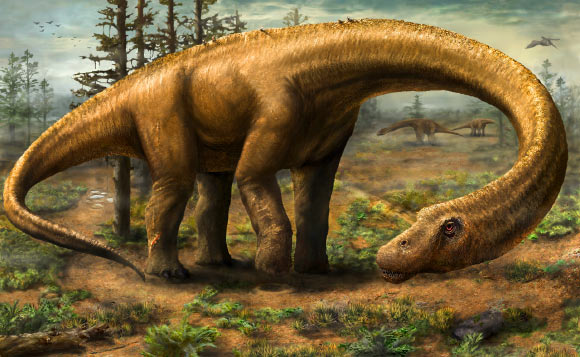
Rendering of Dreadnoughtus schrani in life. Image credit: Jennifer Hall.
Dreadnoughtus schrani lived in temperate forests in what is now the south of South America during the Upper Cretaceous period, around 77 million years ago.
This dinosaur was astoundingly huge – it weighed as much as a dozen African elephants or more than seven T. rexes.
At about 26 m long and a mass of 59.3 tons, it is the largest land animal for which a body mass can be accurately calculated.
2. Pelagornis sandersi, the largest bird ever to fly:

Reconstruction of Pelagornis sandersi. Image credit: Liz Bradford.
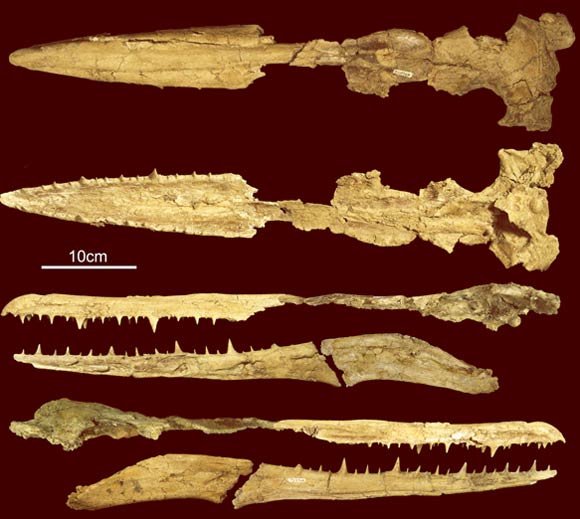
Skull of Pelagornis sandersi in dorsal, ventral, left lateral and right lateral views. Image credit: Daniel T. Ksepka.
Pelagornis sandersi is the largest flying bird yet discovered. At 6.4 m, the wingspan of this bird was about two times that of the Royal Albatross (Diomedea exulans), the largest living flying bird.
It lived in what is now North America approximately 28 million years ago.
3. Aquilops americanus, a small herbivorous dinosaur from Montana:
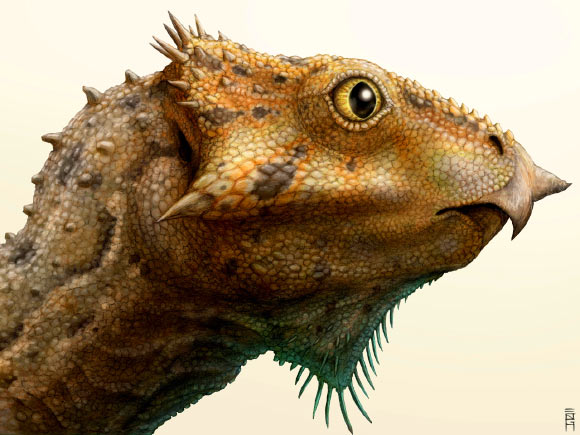
Life restoration of Aquilops americanus. Image credit: Brian Engh / Raymond M. Alf Museum of Paleontology.
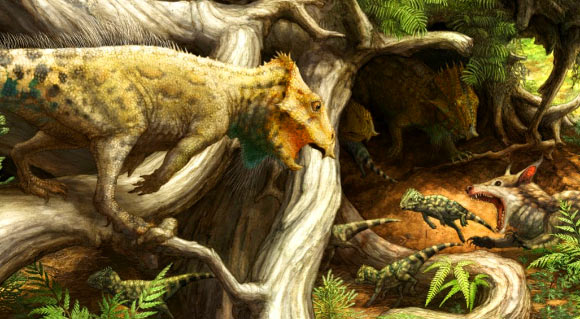
Reconstruction of Aquilops americanus in its environment. Image credit: Brian Engh / Raymond M. Alf Museum of Paleontology.
Aquilops americanus roamed what is now southern Montana during the Early Cretaceous epoch, about 108 million years ago.
It belonged to a group of herbivorous, beaked dinosaurs called Ceratopsia, better known as horned dinosaurs.
Aquilops americanus was about the size of a small cat, weighing around 1.6 kg and measuring around 60 cm in total length.
Unlike its famous relatives, such as Triceratops, it lacked horns and a bony neck frill.
It is the oldest species of horned dinosaur known from North America, about 40 million years older than the iconic horned dinosaur Triceratops, which weighed up to 4,000 times more.
4. Cartorhynchus lenticarpus, the first amphibious ichthyosaur:

Cartorhynchus lenticarpus. Image credit: Ryosuke Motani / University of California, Davis.

This illustration shows what a newly discovered amphibious ichthyosaur may have looked like when it was alive some 248 million years ago. Image credit: Stefano Broccoli / University of Milan.
Cartorhynchus lenticarpus, the smallest ichthyosaur to date, lived in the seas of what is now China during the upper Lower Triassic, approximately 248 million years ago.
The preserved length of the specimen is 21.4 cm; total body length is estimated to be only 40 cm.
It represents a missing stage in the evolution of ichthyosaurs. Its amphibious characteristics include large flippers and flexible wrists, essential for crawling on the ground.
5. Tachiraptor admirabilis, a carnivorous dinosaur from Venezuela:
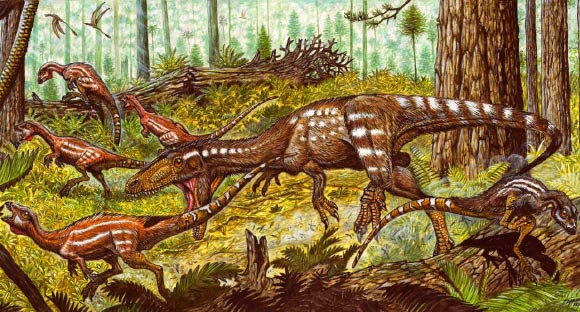
Tachiraptor admirabilis attacking a herd of plant-eating Laquintasaura venezuelae. Image credit: © Maurílio Oliveira / PaleoArt.
Tachiraptor admirabilis is a small bipedal theropod, with an estimated body length slightly over 1.5 meters.
It lived in what is now Venezuela during the earliest part of the Jurassic period, about 201 million years ago.
It belonged to a sister group of Averostra, a large clade of theropod dinosaurs that is known primarily from the Middle Jurassic.
6. Ikrandraco avatar, a new species of pterosaur from China:
Ikrandraco avatar had about 40 pairs of teeth and a throat pouch for catching fish. Image credit: © Chuang Zhao.
Nearly complete skeleton of Ikrandraco avatar. Scale bar – 5 cm. Image credit: Xiaolin Wang et al.
Named after the flying dragon-like creatures from director James Cameron’s blockbuster 2009 movie Avatar, Ikrandraco avatar lived in what is now China during the Cretaceous period, about 120 millions years ago.
It had a wingspan of about 2.5 meters and possessed a throat pouch similar to that of a pelican and probably fed on small fish from freshwater lakes, flying low over the water and catching prey by skimming its lower jaw into the water, and may have stored the fish in the pouch.
7. Atopodentatus unicus, a bizarre reptile from China:
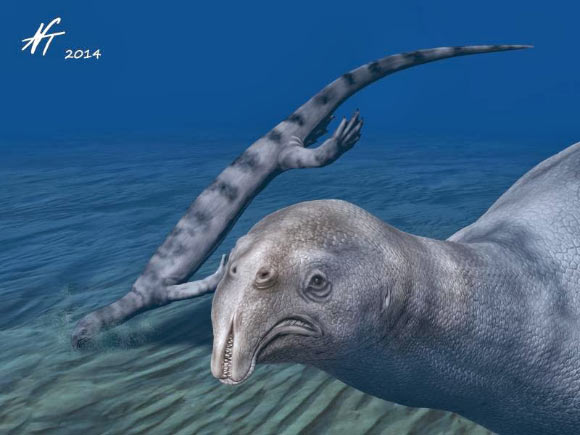
This is an artist’s impression of Atopodentatus unicus. Image credit: © Nobu Tamura, 2014 (spinops.blogspot.com).
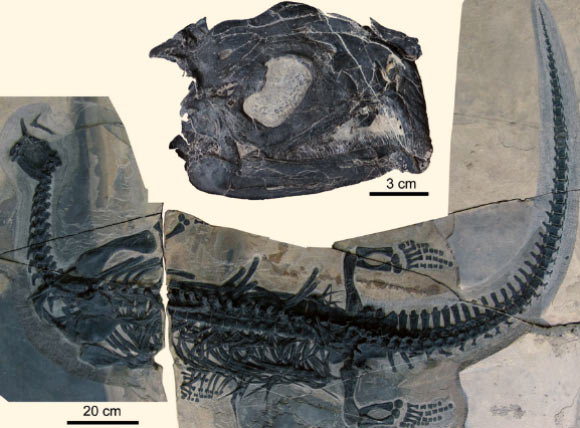
Atopodentatus unicus. Image credit: Long Cheng et al.
Atopodentatus unicus lived in what is now China during the middle Triassic, between 247 and 242 million years ago.
The reptile was about 3 m long and had a long body, short neck and special adaptations for a fully aquatic or semi-aquatic lifestyle.
The most distinguishing characteristic of Atopodentatus unicus is its bizarre mouth. On each side of the mouth, it had about 35 small needle-like teeth in the front of the upper jaw, about 140 small needle-like teeth in the rest of the upper jaw (at least 100 in the horizontal portion and around 35 in the vertical portion), and more than 190 teeth in the lower jaw (about 100 in the horizontal portion and 90 in the shovel-headed anterior end). The teeth were covered by a layer of enamel.
8. Rhinorex condrupus, a new species of hadrosaur from Utah:

Rhinorex condrupus attacked by a Cretaceous crocodile. Image credit: © Julius Csotonyi.

Rhinorex condrupus skull and its reconstruction; abbreviations: nap – nasal anteroventral process; ppd – premaxilla posteroventral process dorsal expansion. Scale bar – 10 cm. Image credit: Terry A. Gates / Rodney Scheetz.
Rhinorex condrupus lived in swampy estuarial environments during the Cretaceous period, about 75 million years ago.
It was about 9 meters long and weighed over 3,800 kg.
Hadrosaurs are usually identified by bony crests that extended from the skull, but Rhinorex condrupus lacked a crest on the top of its head; instead, it had a huge nose.
9. Leinkupal laticauda, a sauropod dinosaur from Argentina:

This is an artist’s impression of Leinkupal laticauda and smaller carnivorous dinosaurs. Image credit: © Jorge Antonio Gonzalez.
Leinkupal laticauda roamed what is now Argentina during the early Cretaceous, between 146 and 100 million years ago.
It belongs to the family Diplodocidae, a group of sauropod dinosaurs recorded in late Jurassic strata from North America, Europe, Africa, and well known for their large bodies, as well as extremely long necks and tails.
It is the first diplodocid discovered in South America, the second confirmed diplodocid for the ancient continent Gondwana and the youngest record of Diplodocidae in the world.
Paleontologists estimate that Leinkupal laticauda could reach 9 meters long.
10. Torvosaurus gurneyi, a giant dinosaur from Portugal:

Torvosaurus gurneyi. Image credit: © Sergey Krasovskiy.
Torvosaurus gurneyi lived in what is today Europe during the Jurassic period, approximately 150 million years ago.
It was about 10 m long and weighed 4-5 tons. It had blade-shaped teeth up to 10 cm long, which indicates the dinosaur may have been at the top of the food chain.
11. Caiuajara dobruskii, a species of pterosaur from Brazil:
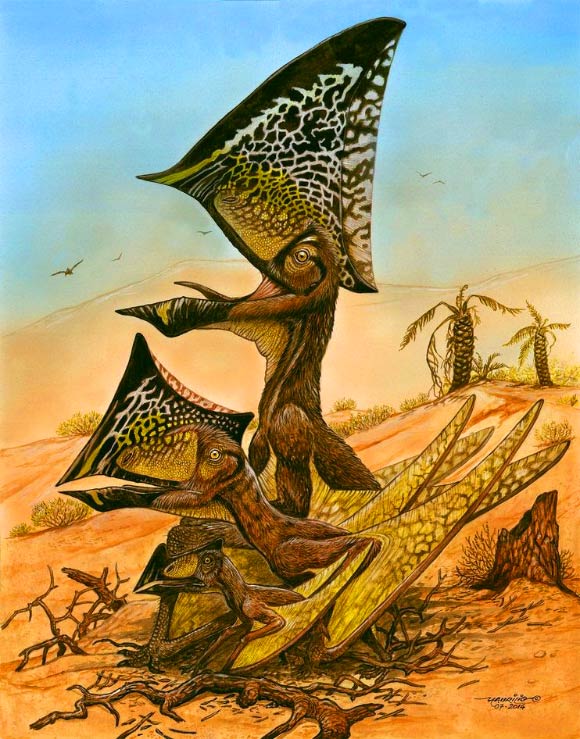
This is a reconstruction of three growth stages of Caiuajara dobruskii. Image credit: Maurilio Oliveira / Museu Nacional-UFRJ.

Selected cranial material of Caiuajara dobruskii. Image credit: Manzig PC et al.
Caiuajara dobruskii lived in what is now southern Brazil between 94 and 72 million years ago, in the Cretaceous period.
This reptile was gregarious, living in colonies, and most likely precocial, being able to fly at a very young age.
12. Kulindadromeus zabaikalicus, a feathered herbivorous dinosaur:

Reconstruction of Kulindadromeus zabaikalicus. Image credit: Andrey Atuchin.
Kulindadromeus zabaikalicus roamed lake-dotted lowlands of Jurassic Siberia, between 169 and 144 million years ago.
It was a small plant-eater, only about 1 meter long, had long hind legs and short arms.
It had scales on its tail and shins, and short bristles on its head and back. It also had complex, compound feathers on its arms and legs.
13. Qianzhousaurus sinensis, a long-snouted tyrannosaur from China:

This image shows two individuals of Qianzhousaurus sinensis and a small feathered dinosaur called Nankangia. Image credit: Chuang Zhao.

Skull of Qianzhousaurus sinensis: top – lateral view, middle – dorsal view, bottom – ventral view. Scale bar – 5 cm. Image credit: Junchang Lü et al.
Qianzhousaurus sinensis (nicknamed Pinocchio rex) lived in Asia during Cretaceous, about 66 million years ago.
It measured about 9 m from snout to tail, and had an elongated skull, long teeth compared with the deeper, more powerful jaws and thick teeth of a conventional Tyrannosaurus.
14. Eocasea martini, the oldest known ancestor of land herbivores:

This is an artist’s reconstruction of Eocasea martini. Image credit: Danielle Dufault.

Photograph and interpretive drawing of the Eocasea martini fossil. Preserved parts of the skeleton include the posterior 1/3rd of the skull and mandible, the vertebral column with ribs, pelvic girdle and right hind limb. Abbreviations: as – astragalus; ca – calcaneum; f – femur; fi – fibula; il – ilium; is – ischium; pu – pubis; s1 – first sacral rib; s2 – second sacral rib; t – tibia; roman numerals indicate the digit number in the pes. Image credit: Reisz RR, Fröbisch J.
Eocasea martini, the oldest known ancestor of terrestrial herbivores, lived in what is today Kansas during Carboniferous period, about 300 million years ago.
It was about 20 cm long and weighed less than 2 kg as an adult. It belonged to the caseid branch of Synapsida, a group representing an ancient lineage leading by stages to the mammals.







